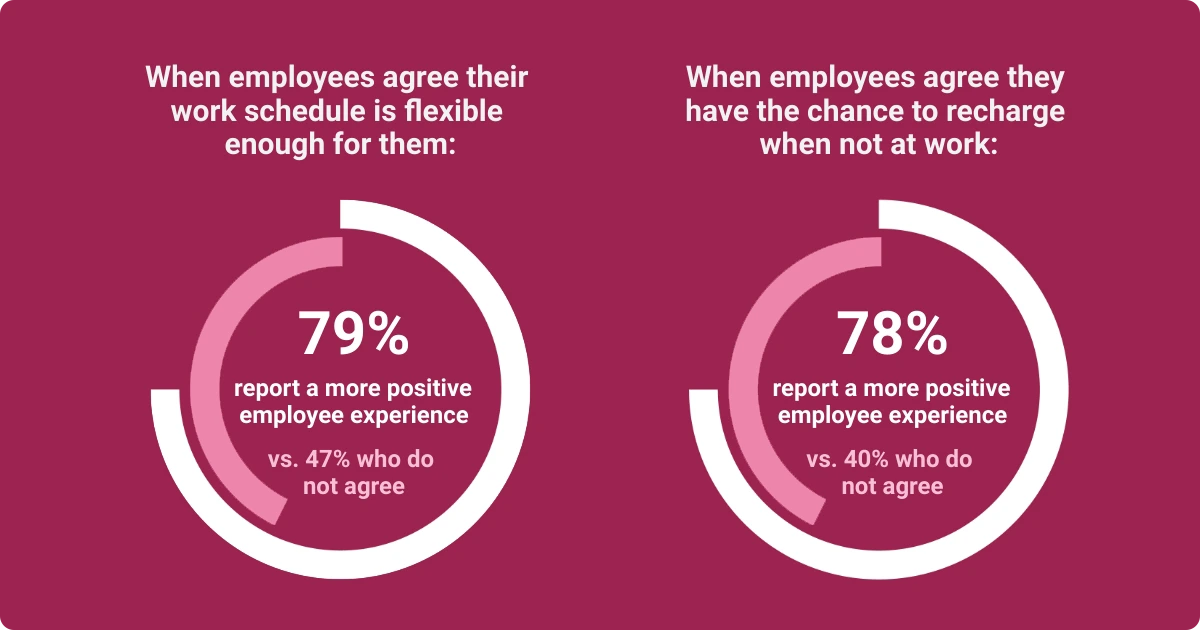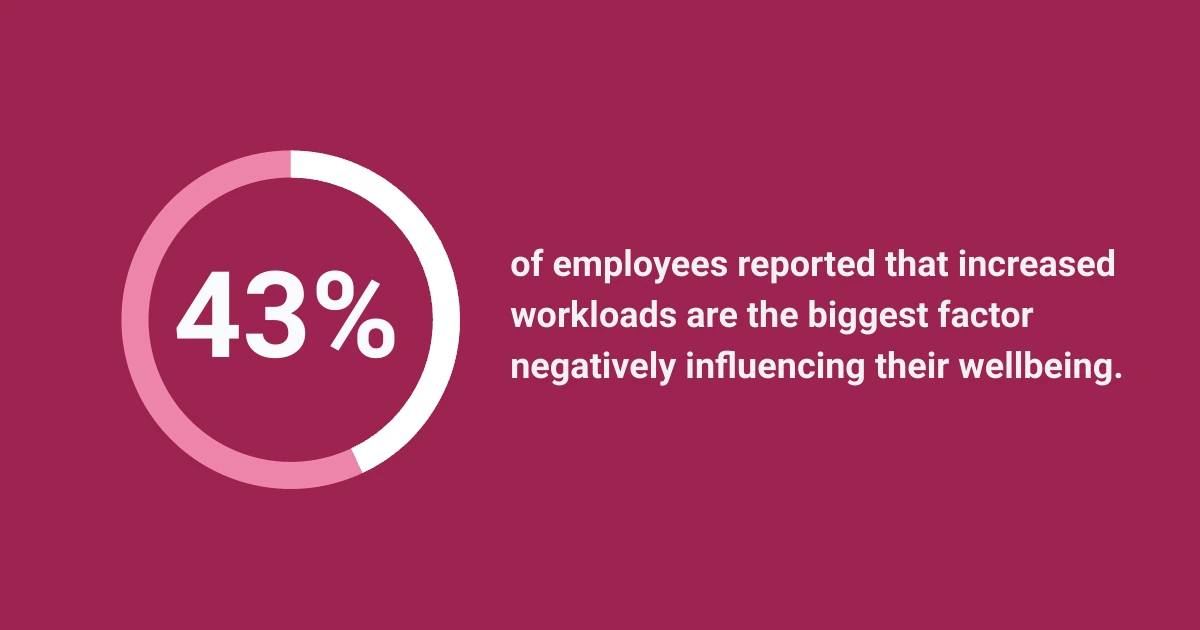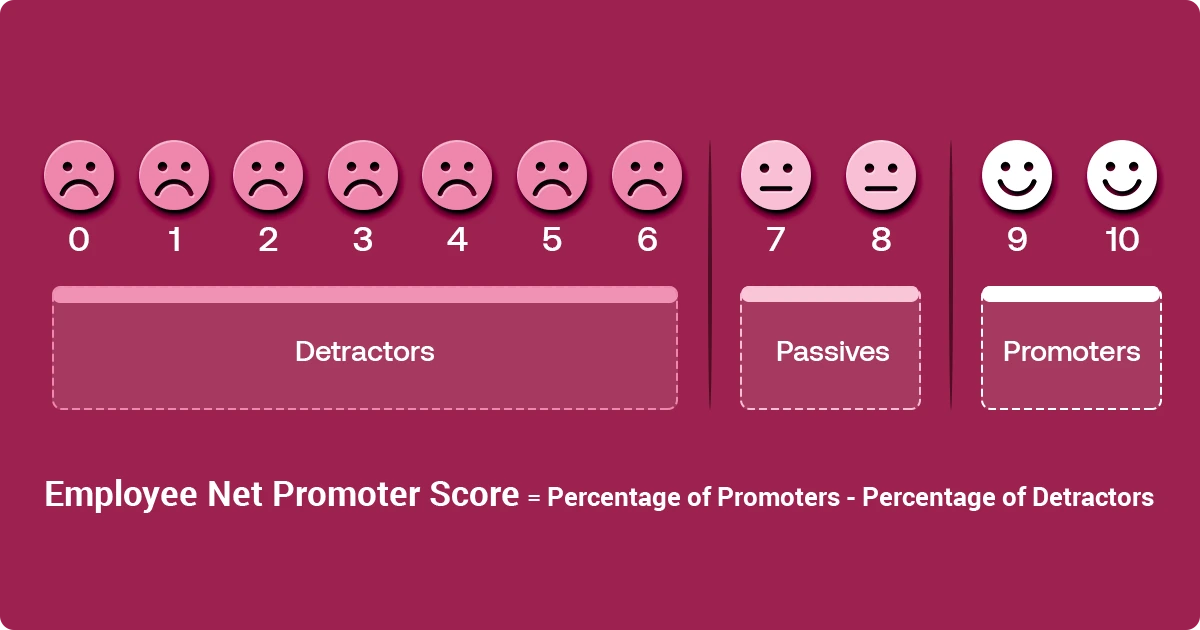Essential Employee Wellbeing Metrics: How to Effectively Measure Employee Wellness

It’s no secret that healthy, happy employees tend to perform better. According to GallupOpens in a new tab, companies in the top quartile of employee engagement have 18% higher productivity and 23% greater profitability than those in the bottom quartile.
Employee wellness has become a top priority for many businesses, but it’s not always easy to measure. Your staff may seem enthusiastic and engaged, but are they truly thriving? That’s where employee wellbeing metrics come in. These measurable indicators help organizations assess their workforce’s physical, mental, and emotional health.
This guide covers everything you need to know about how to measure wellbeing at work. We’ll also share practical tips for analyzing and improving these metrics so you can promote a positive work culture.
Why employee wellbeing metrics matter
You care about your team and want them to thrive both personally and professionally. However, the importance of employee wellbeing goes beyond individual growth — it directly affects workplace productivity and company success.
According to Gallup–Workhuman’s “The Opportunity Cost of Wellbeing”, low employee health and wellness leads to:
- Higher absenteeism
- Higher turnover
- Increased burnout
- Reduced productivity
These factors drain performance, costing companies a staggering $20 million for every 10,000 workers. Even if you only have a small workforce, the impact on productivity and profitability can be significant.
Measuring employee wellbeing allows you to identify areas for improvement and support your workers more effectively. For example, if absenteeism is high, free counseling and other employee mental health resources could help. If turnover rates climb, professional development opportunities might boost retention.
Additionally, the benefits of employee wellbeing programs often go hand in hand with broader organizational goals. These initiatives can improve employee satisfaction, boost engagement, and shape a more inclusive workplace culture.
Key employee wellbeing metrics to track
There are dozens of employee wellness metrics, from burnout rates to stress levels. This metaphorical avalanche of data can feel overwhelming, especially if you’re just starting to monitor employee wellbeing and productivity. The good news? You don’t need to track everything.
Here are a few key metrics to focus on when assessing employee wellbeing:
Physical wellbeing metrics
If you’ve ever gotten a headache during a frustrating meeting, you know that stress and anxiety can take a toll on the body. Over time, these effects can lead to significant, long-term health issues.
According to a literature reviewOpens in a new tab, workplace stress can affect cardiovascular health, the immune system, sleep, metabolism, and other critical functions.
Keep a close eye on your team’s physical health by tracking these employee wellbeing metrics:
Absenteeism rates
Your employees aren't robots, so they'll need to take sick days sooner or later. Tracking the frequency and reasons for sick leave can provide valuable insights into your team’s overall physical and mental health.
By analyzing this data, you can spot patterns that may point to burnout or workplace-related health issues. For example, if sick leaves spike during peak seasons, it could indicate that employees are feeling overwhelmed or stressed. You might address this issue by hiring temporary staff or offering flexible work arrangements.

Health risk assessment participation
Many organizations offer free health risk assessments for employees. Measuring participation rates will help you gauge your team’s awareness of these programs and their investment in their health. If participation is low, consider offering incentives, such as gift cards or an extra day of paid time off.
Fitness program engagement
Yoga classes, lunch break walking clubs, and other fitness programs help employees stay active. By monitoring engagement with these activities, you can gain insights into your workforce’s physical wellbeing.
This data also lets you identify the most popular programs and spot opportunities to expand your offerings. For instance, if employees love your annual Christmas 5K, you might add more friendly competitions throughout the year to increase engagement.
Healthcare cost trends
If your company offers health insurance, your provider can share a wealth of data, including:
- Claims
- Number of emergency room visits
- Prevalence of chronic conditions, such as diabetes and heart disease
- Prescription drug usage and costs
- Usage of preventative care services
- Utilization rates
This data can provide insights into employee physical health and the effectiveness of wellness programs. For instance, if only a few employees take advantage of annual check-ups and vaccines, it could lead to more serious health issues down the line.
Similarly, if the number of emergency room visits increases, your workers may be experiencing more acute health issues. Based on these patterns, you might promote health education and preventative care services to proactively address conditions.
Pay attention to overall healthcare expenses, too. Increasing costs may indicate rising health issues that may be compounded by workplace stress. By contrast, stable or reduced costs might reflect successful health initiatives.
Participation rates in wellbeing programs
Your organization invests a lot of effort into wellbeing programs, and you want your employees to attend. Measuring participation rates will help you understand if your workplace wellbeing strategy meets your employees’ needs.
High participation indicates that your employees value your wellbeing efforts, while low participation may suggest that your programs aren’t well-communicated or aren’t engaging your team. You might be offering meditation sessions, but your employees actually want free gym memberships, or maybe they haven’t even heard about the program.
Mental health metrics
Mental health may not be as visible as physical health, but it’s just as important for employee wellbeing. Use these metrics to monitor and support mental wellness in the workplace.
Employee stress levels and work-life balance
Stress is an unavoidable part of life, but too much stress can harm mental health, especially when combined with poor work-life balance. In a Workhuman studyOpens in a new tab, 43% of employees reported that increased workloads are the biggest factor negatively influencing their wellbeing.

Surveys and pulse checks — short, frequent questionnaires — are two of the most effective ways to track employee stress levels and work-life balance. These tools allow you to glean insights into your team’s mental and emotional health. For example, you could survey them about their sleep habits or ask how you can best support them.
Monitoring stress levels will also help you identify stressors early and step in before employees burnout. These interventions may involve reassigning tasks, adding more staff, or helping workers develop healthy coping strategies.
Utilization of mental health resources
Obviously, you want employees to take advantage of the mental health resources you’ve provided — that’s what they’re there for. But if you see more people using them, it could mean employees are facing new challenges or dealing with more stress. By contrast, low usage rates might suggest workers don’t know about available resources or are hesitant to use them.
Employee burnout rates
Burnout is one of the biggest threats to workplace health, productivity, and retention. According to research from Workhuman's "Amplify Wellbeing at Work and Beyond" report, employees who feel burned out are 63% more likely to be absent and over twice as likely to search for another job.
The Maslach Burnout InventoryOpens in a new tab is the most common assessment tool. This 22-question survey detects the risk of burnout by evaluating exhaustion, depersonalization, and personal achievement.
Overtime hours
Tracking overtime will help you identify overworked employees who may have taken on too much. A 2022 Substance Abuse and Mental Health Services Administration report found that excessive overtime can contribute to burnout and emotional exhaustion. These conditions negatively impact both individual well-being and team productivity.
Workplace engagement metrics
Employee engagement is another critical indicator of overall wellbeing. Workers who feel highly engaged are typically happier and more motivated. They’re often eager to build connections with colleagues and grow professionally. On the other hand, employees with low engagement may feel disconnected or unmotivated, and they might need extra support to thrive.
Here are a few vital engagement metrics:
Employee satisfaction levels
Employee satisfaction plays a significant role in mental and physical wellbeing. A 2024 Psychiatry International studyOpens in a new tab found that “higher job satisfaction predicted greater life satisfaction, fewer mental symptoms, and greater psychological well-being.”
Regular surveys can help your organization gauge employee satisfaction levels. To get the most honest answers, make these questionnaires anonymous. Use the responses to address concerns early and make informed decisions about improving workplace culture. For instance, you could offer conflict resolution training if several employees report disputes with colleagues.
The Employee Net Promoter Score is another effective tool for measuring engagement and satisfaction. It asks one question: “How likely are you to recommend your employer to others as a place of work?” Employees use a scale from 1 (not at all likely) to 10 (extremely likely) to rate their response.
The eNPS system divides participants into three categories based on their responses:
- Detractors (0-6): Very unsatisfied and likely to seek employment somewhere else
- Neutrals: (7-8): Generally satisfied but might still leave
- Promoters (9-10): Very satisfied and loyal to the company
A high percentage of detractors suggests your organization needs additional wellness programs to increase morale and satisfaction.

Employee productivity trends
Productivity levels can provide insights into the overall wellbeing of your workforce. Steady or increasing productivity suggests that employees are deeply engaged and motivated. However, reduced productivity could signal burnout, disengagement, or health issues.
Turnover rates
Employee turnover and retention are vital metrics for measuring workplace wellbeing. Strong retention often indicates that workers are engaged and satisfied with their roles. After all, people tend to stay in jobs they enjoy, even when other opportunities are available.
High turnover rates can signal a toxic or unsupportive work environment. The good news is that early intervention can help reverse this trend. According to a 2024 Gallup reportOpens in a new tab, company leadership could prevent 42% of voluntary departures.
Financial wellbeing metrics
Financial health is an important but often overlooked aspect of employee wellbeing. Helpful financial wellness metrics include:
- Participation in financial wellness programs, such as retirement planning sessions
- Feedback on financial stress levels from surveys or focus groups
How to collect and analyze employee wellbeing metrics
You don’t need a background in data science to learn how to measure employee wellbeing. With the right tools and methods, you can start gaining meaningful insights quickly.
Tools for tracking metrics
There are many user-friendly employee wellbeing tracking tools, including:
- Workhuman uses Human Intelligence™ to provide intuitive and insightful HR analytics for wellbeing. The platform gathers and analyzes data about employee retention, engagement, and other key wellness metrics. It also generates accessible data visualizations to reveal patterns and trends.
- Culture Amp assesses employee engagement and creates personalized action plans to implement insights.
- Qualtrics is a popular survey platform with artificial intelligence (AI)-powered analytics tools that you can use to analyze employee feedback.
Methods of data collection
Surveys and self-assessments are among the most straightforward ways to gather data. Focus on creating clear and concise questions related to your goals. For example, if you want to improve employee satisfaction, you might ask, “Do you feel like your manager cares about your success?”
Attendance records and performance metrics can also provide insights into employee well-being. Look for long-term trends — like increasing sick leave — that may suggest that employees are facing challenges.
Best practices for data analysis
Data analytics is a powerful tool, but you must wield it responsibly. Use robust cybersecurity measures like multi-factor authentication to protect data privacy and confidentiality, and always delete information when you’re done with it.
Additionally, you should compare your organization’s metrics to workplace wellbeing benchmarks. These standards will help you understand how your employee wellbeing stacks up to competitors and identify opportunities for improvement.
Strategies to improve employee wellbeing metrics
Once you understand how to measure employee wellness, you can take steps to improve it. Here are a few proven workplace wellness strategies:
- Offer flexible work schedules, which, according to The Future Forum Pulse surveyOpens in a new tab, can reduce burnout by 26% and increase job satisfaction
- Provide access to mental health resources, such as employee assistance programs and mindfulness workshops
- Encourage work-life balance by restricting overtime
- Host employee wellbeing initiatives, such as financial literacy workshops and yoga sessions
For more inspiration, study how other businesses are improving employee wellbeing. For instance, Nike employees receive up to 20 free counseling sessions yearly, free financial coaching, and professional development opportunities.
Challenges in measuring employee wellbeing
Measuring workplace wellness may raise challenges, especially in the beginning. Employees may hesitate to share personal data or worry they’ll get penalized for sharing their honest experiences.
Wellbeing data limitations can also pose major obstacles. For example, qualitative factors like happiness and loyalty are difficult to quantify. It’s also not easy to balance short-term vs. long-term wellbeing impacts. A health initiative may temporarily boost morale but negatively affect long-term engagement.
Effective communication can overcome these challenges. Practice transparency by explaining how and why you’ll use employee data, and allow employees to respond anonymously whenever possible to build trust.
The future of employee wellbeing metrics
Keeping up with the latest trends in workplace wellbeing metrics will help you provide the best support for your employees.
Artificial intelligence is one of the latest advancements in this area. For example, Workhuman’s innovative AI Assistant provides more sophisticated insights into your employee wellness program. It also offers predictive analytics for wellbeing, so you can anticipate how specific initiatives will impact your employees before you invest in them.
Many organizations have also embraced a holistic approach by offering various types of health and wellbeing resources. For example, you might organize a Monday morning walking club to get employees moving or make Fridays remote to support mental health. This strategy allows you to support every aspect of employee wellbeing, helping your workers become more well-rounded individuals.
Conclusion
Promoting employee wellness isn’t just a fleeting trend; it’s the key to company success. By monitoring employee wellbeing metrics, you’ll better understand your team’s needs and learn what they need to thrive.
Start tracking the right metrics today to build a positive and supportive workplace culture. This process will allow you to assess, improve, and expand your current wellbeing programs. By applying data analytics strategically, you’ll empower your employees to excel inside and outside the workplace.